6 Best Grass Types for Corpus Christi, TX
BY KIMBERLY MAGERL | MAY 25TH, 2023 | CORPUS CHRISTI, LAWN CARE, TEXASCorpus Christi’s average temperatures range from 50 to 95 degrees Fahrenheit. This Southeast Texas beach town is the heart and soul of the Gulf Coast. Named the “Birdiest City in North America,” Corpus Christi has a humid subtropical climate with mild winters that cater to wildlife year-round. The best grass types for Corpus Christi thrive in the city’s long, hot summers. If you are installing a new lawn or looking to freshen up your existing yard, consider one of these options for your Gulf Coast landscape.
- FAQ About Corpus Christi Grass Types
- Choose Plants and Grass Varieties for Your Corpus Christi Landscape
Warm-Season vs. Cool-Season Grasses
Texas and heat go hand-in-hand, and this time we aren’t talking about barbecue. It’s no surprise that the ninth hottest city in Texas benefits from sun-loving native plants and warm-season grass cultivars that prefer growing temperatures between 80 to 95 degrees Fahrenheit.
Warm-season grasses come from tropical regions, making them well-adapted to Corpus Christi’s humid climate. These turfgrasses soak up the sun and actively grow year-round in Southeast Texas, though growth slows during the milder winter months.
All types of grass are classified into one of two categories:
- Warm-season grasses perform best in the southern half of the United States. They grow most actively in late spring and summer when temperatures are around 75 to 95 degrees Fahrenheit.
- Cool-season grasses are well-suited to northern climates with cold winters and distinct seasons. They grow most actively in early spring and fall when temperatures are around 55 to 75 degrees Fahrenheit.
6 Warm-Season Grasses for Corpus Christi
The following warm-season grass types are perfectly suited for the climatic and soil conditions of Corpus Christi:
1. Bermudagrass
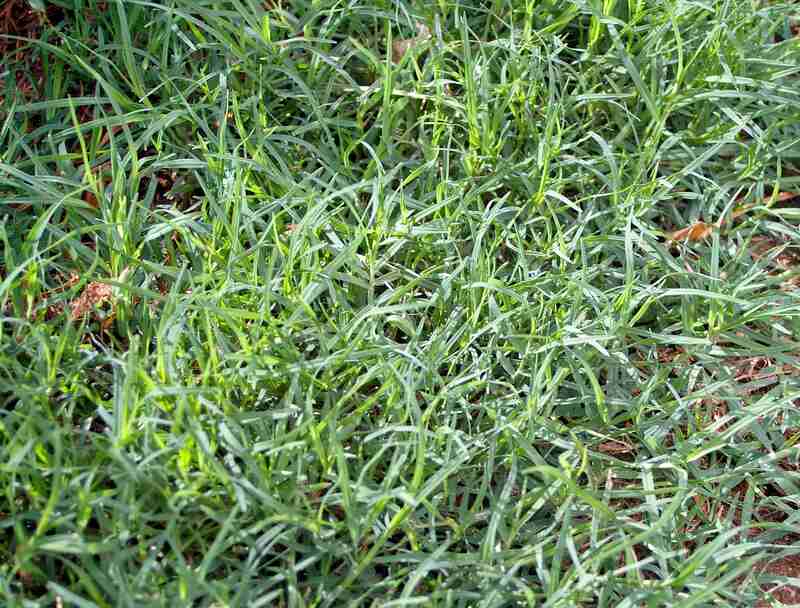
Photo Credit: Bidgee / Wikimedia Commons / CC BY-SA 3.0
Bermudagrass is a common warm-season turfgrass that ranges from coarse to fine-textured and withstands salt, drought, and heavy traffic. It is the most popular Texas grass variety and a versatile option used for everything from athletic fields and golf courses to home lawns and parks. Cultivars recover quickly from damage, leading some to consider it an aggressive species.
Corpus Christi is home to common and hybrid bermudagrass varieties. Common bermudagrass has a light green color and coarse texture, while hybrid cultivars have a finer texture and dark green appearance. Hybrid varieties require more maintenance than common bermudagrass, but they are more dense forming a carpet-like layer.
Classification: Warm-season grass
Spreads by: Stolons and rhizomes
Shade tolerance: Poor — needs full sun
Drought resistance: High
Foot traffic tolerance: High
Maintenance needs: Needs frequent mowing due to fast growth rate; develops thatch easily; needs regular fertilization
Mowing height: 1-2 inches
Potential for disease: Good resistance to disease; prone to spring dead spot, dollar spot, leaf spot, large patch, and sheath spot
Potential for pests: Low resistance; prone to white grubs, hunting billbugs, mole crickets, armyworms, and sod webworms
Soil pH: 6-6.5
Soil type: Tolerates most soil types
Other notes: Bermuda spreads aggressively via its stolons (above-ground stems) and rhizomes (below-ground stems) and can out-compete many weeds. The downside is that it also can be a nuisance and is sometimes considered invasive. You’ll often find it has tunneled underground into flower beds and spread into neighboring lawns.
2. St. Augustinegrass
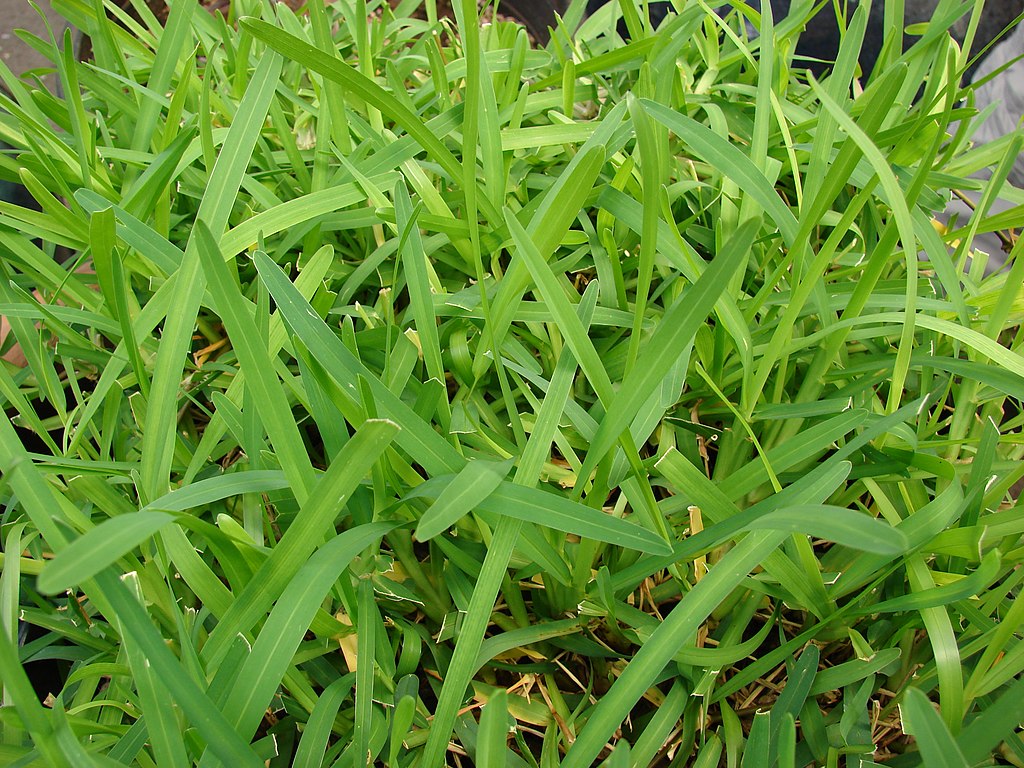
Photo Credit: Forest & Kim Starr / Wikimedia Commons / CC BY 3.0 US
St. Augustinegrass is native to warm coastal regions. It is the most shade-tolerant warm-season cultivar. St. Augustinegrass has an attractive dense appearance and deep roots that make it moderately drought and salt-tolerant. Unfortunately, this turfgrass struggles during bouts of cold weather and does not tolerate heavy traffic or herbicides well.
St. Augustinegrass is quick-growing and has an enviable blue-green color. The most popular cultivars in Texas are Raleigh, Palmetto, and Floratam. Both Raleigh and Palmetto have a high cold and frost resistance compared to other St. Augustine varieties. All cultivars are susceptible to disease and pests like chinch bugs.
Classification: Warm-season grass
Spreads by: Stolons
Shade tolerance: Moderate shade tolerance, among the highest of any warm-season grass; some cultivars are more shade tolerant than others
Drought resistance: Moderate
Foot traffic tolerance: Moderate
Maintenance needs: Moderate to high mowing frequency
Mowing height: 2.5-4 inches (mow dwarf varieties from 2.5-3 inches; standard cultivars from 3-4 inches; mow tall in shade)
Potential for disease: Moderate to high; prone to gray leaf spot, large patch, and take-all root rot
Potential for pests: High; prone to chinch bugs, cutworms, mole crickets, grass loopers, armyworms, webworms, and grubs
Soil pH: 6-7.5
Soil type: Tolerates many soil types; prefers moderately fertile and moist (not waterlogged) soils; not a highly drought-tolerant grass; doesn’t tolerate soil compaction
Other notes: Native to coastal areas across the world and prefers moist soils and mild winters; will thrive in more inland areas provided growing conditions are met; good salt tolerance; will go dormant during winter in all but the southernmost regions
3. Zoysiagrass
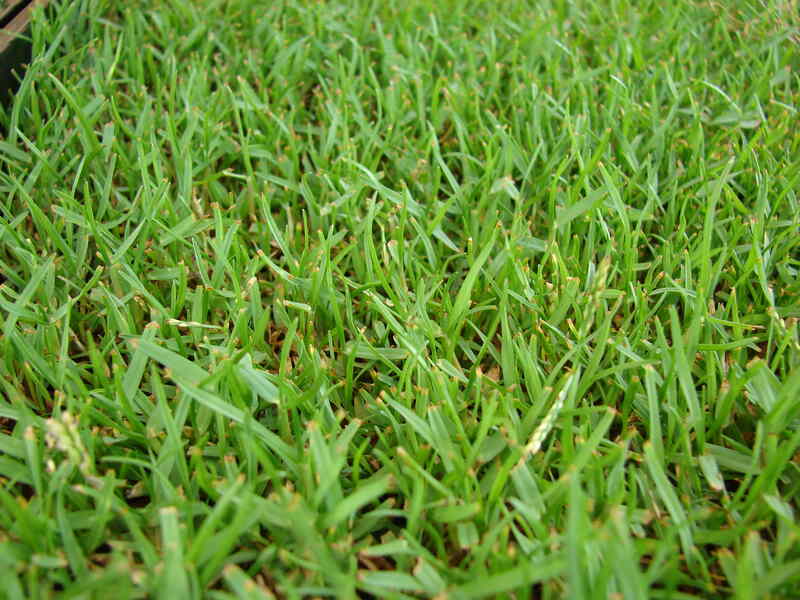
Photo Credit: Forest and Kim Starr / Flickr / CC BY 2.0
Texas is home to around 11 cultivars of Zoysiagrass. These grasses tolerate low mow heights, drought, cold, shade, and heavy traffic, and have low fertilization requirements. New cultivars have increased disease and pest resistance. Zoysiagrass grows densely, blocking out weed growth thanks to thick stiff leaf blades.
Similar to St. Augustinegrass’ carpet-like appearance, Zoysiagrass is recognizable for its dense appearance and dark green color. Fortunately, cultivars are not prone to disease or insect infestations and grow slowly.
Classification: Warm-season grass
Spreads by: Stolons and rhizomes
Shade tolerance: Tolerates light to moderate shade
Drought resistance: High
Foot traffic tolerance: High
Maintenance needs: Low to moderate nitrogen requirement; moderate mowing frequency
Mowing height: 1-2.5 inches
Potential for disease: Low; large patch, root decline, spring dead spot, rust, curvularia, and lead spot can occur
Potential for pests: Low; most common pests are mites, grubs, mole crickets, hunting billbugs, armyworms, chinch bugs, and sod webworms
Soil pH: 6-6.5
Soil type: Well-draining, some cultivars more tolerant of a wide range of soils than others
Other notes: Moderately salt tolerant; cut with sharp mower blade; mow taller if grass is in partial shade
4. Centipedegrass
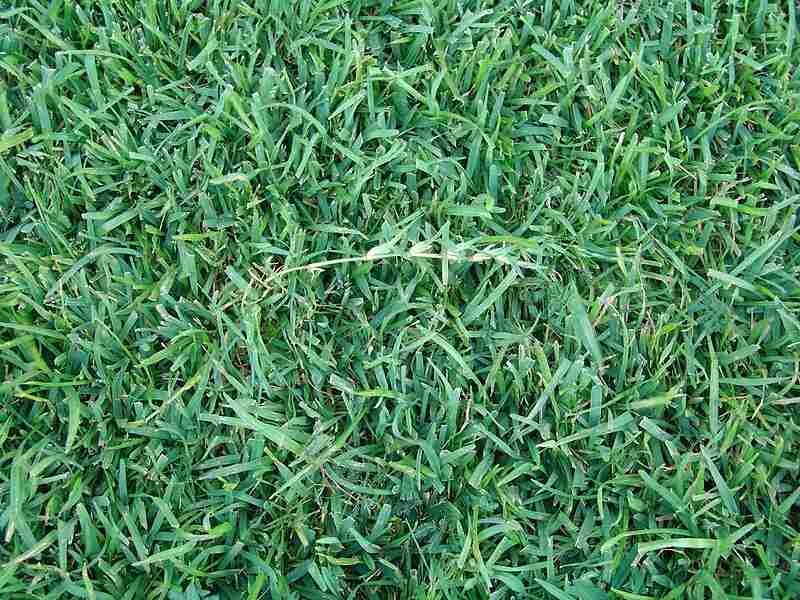
Photo Credit: James Becwar / Wikimedia Commons / CC0 1.0
Centipedegrass is another slow-growing cultivar with a tight growing pattern and fine leaf blades. The low-maintenance turfgrass is prone to disease and pests when improperly maintained and over watered. It is a smooth, flat-bladed grass that likes to be left alone.
Centipedegrass has a pronounced light green color and a medium texture. Cultivars require little mowing, fertilization, or water to remain green. This turfgrass handles shade but prefers full sun like most warm-season grass varieties.
Classification: Warm-season grass
Spreads by: Stolons
Shade tolerance: Moderate — at least six hours of full sun per day
Drought resistance: Low to moderate
Foot traffic tolerance: Low
Maintenance needs: Low mowing frequency
Mowing height: 1.5-2 inches
Potential for disease: Moderate; prone to centipedegrass decline and iron chlorosis
Potential for pests: Moderate; prone to ground pearl insects, grubs, mole crickets, sod webworms, and lawn caterpillars
Soil pH: 5-6
Soil type: Acidic, infertile, at least moderately good drainage (very dense, clay soils produce poor results)
Other notes: Low maintenance once established; greenish-yellow color (like a green apple) during the growing season; low fertilizer and mowing requirements; not a salt-tolerant grass
5. Buffalograss
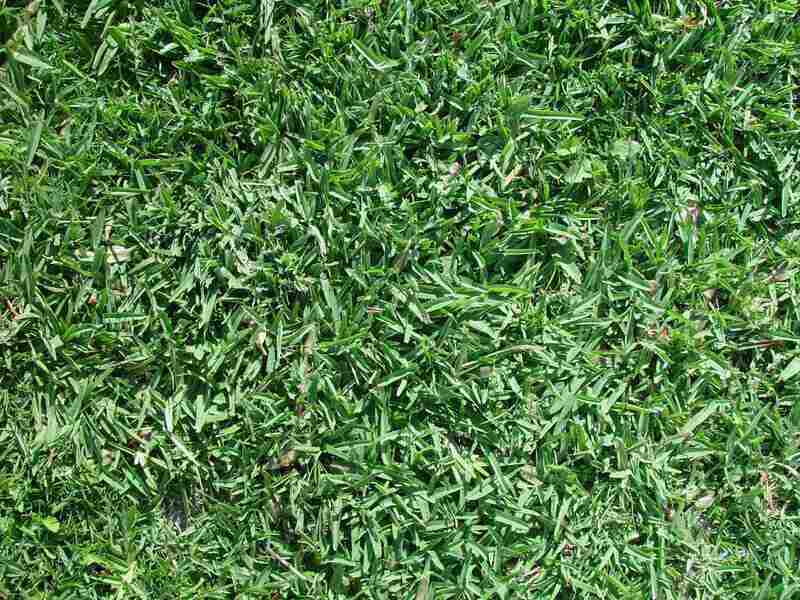
Photo Credit: Pixnio
Native plants are always a desirable choice for any landscape. Buffalograss is a Texas native turfgrass that loves the sun. The warm-season grass is drought and cold-tolerant and requires little fertilization and less mowing than most varieties.
Buffalograss loves long hot summers and its gray-green blades are pest and disease resistant. Unfortunately, the low-fuss cultivar does not stand up to heavy traffic, shade, or weeds.
Classification: Warm-season grass
Spreads by: Stolons
Shade tolerance: Very low — best suited for full sun
Drought resistance High
Foot traffic tolerance: Very low, but light use or rare heavy use is OK
Maintenance needs: Low mowing frequency — once per week or less
Mowing height: 2-4 inches or leave unmowed
Potential for disease: Low; bipolaris leaf spot may occur
Potential for pests: Low; most common pests are mealybugs, buffalograss webworms, mites, short-tailed crickets, and chinch bugs
Soil pH: 6.5-7.5
Soil type: Native soils, not sandy soils
6. Seashore Paspalum
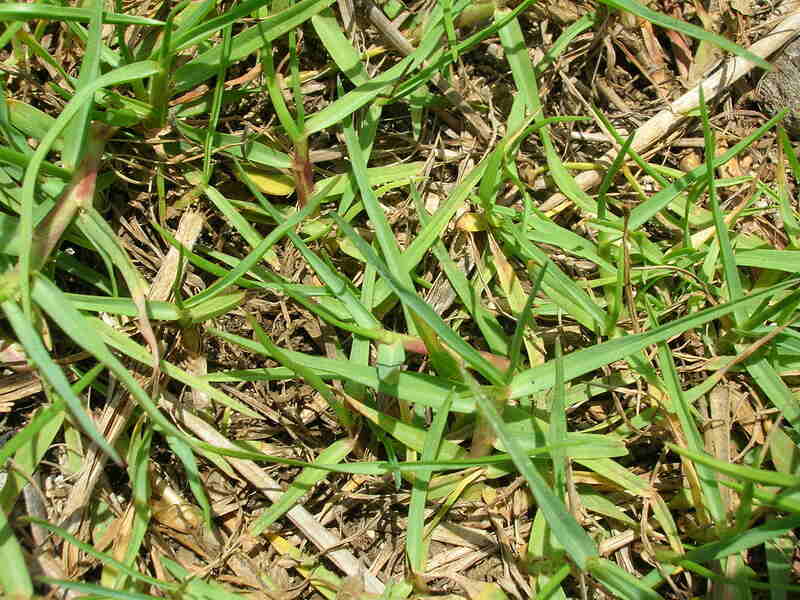
Photo Credit: Forest & Kim Starr / Wikimedia Commons / CC BY 3.0
Seashore paspalum is similar to bermudagrass but has quicker root development. This warm-season cultivar is extremely salt-tolerant and grows in all types of soil. Like bermudagrass, it has an aggressive growth habit and coarse blades with a dense root system.
Seashore paspalum is light to medium green in color and requires frequent mowing to maintain a low height. This popular coastal turfgrass tolerates hot temperatures, drought, shade, and heavy traffic. It has the lowest nitrogen requirements of any warm-season turfgrass. Unfortunately, seashore paspalum cultivars are more expensive than other varieties.
Classification: Warm-season grass
Spreads by: Stolons and rhizomes
Shade tolerance: High
Drought resistance High
Foot traffic tolerance: High
Maintenance needs: Needs frequent mowing due to fast growth rate; moderate water and fertilization needs
Mowing height: 1-2 inches
Potential for disease: Low; fusarium blight and Helminthosporium disease may occur
Potential for pests: Low; most common pests are mole crickets, sod webworms, spittlebugs, white grubs, billbugs, cutworms, and fall armyworms
Soil pH: 4.5-9.0
Soil type: Adaptable; does not prefer a specific soil type
Other notes: Sensitive to dull mower blades and prone to injury from tearing
FAQ About Corpus Christi Grass Types
Warm-season grasses grow best when the Texas temperatures hit 80 degrees Fahrenheit, usually toward the beginning of May. The growing season typically slows when temperatures dip below 80 degrees Fahrenheit around the end of October.
Texas turfgrasses typically go dormant when temperatures drop below 45 degrees Fahrenheit around mid-November, though this does not always occur in Corpus Christi.
You should plant your grass seed in March or April. This gives the seed plenty of time to germinate before the hot Texas summer.
St. Augustinegrass and seashore paspalum are the most shade-friendly grass types for Corpus Christi.
Dogs and cats love to soak up the summer sun as much as your Texas plants. If your furry friend spends a lot of time outdoors, bermudagrass and seashore paspalum are your best options. These varieties grow densely, withstand heavy traffic, and recover quickly when man’s best friend has the urge to dig.
Choose Plant and Grass Varieties for Your Corpus Christi Landscape
All Texas grass cultivars have different characteristics and needs. Choose a variety that works well for your lifestyle and your yard’s microclimate. Warm-season varieties are the best option for your Corpus Christi lawn. They are suited to Southeast Texas’ unique USDA Zones, 9a, 9b, and 10a.
Corpus Christi’s year-round warm weather lends itself to numerous landscaping options. Beat the heat with our list of low-maintenance landscaping ideas or batten down the hatches and gear up for the Gulf’s hurricane season with hurricane-resistant landscaping options.
A lush backyard oasis is within reach. Contact a Corpus Christi lawn care pro today to keep your lawn and landscaping healthy.
Main Image Credit: Wozzy25 / Wikimedia Commons / CC BY-SA 3.0